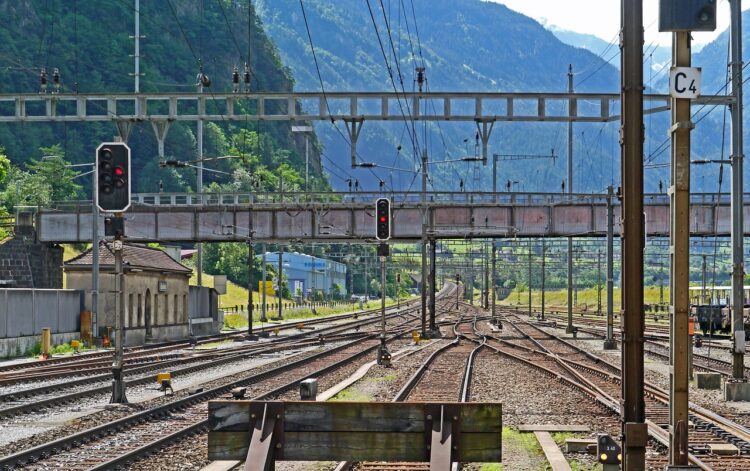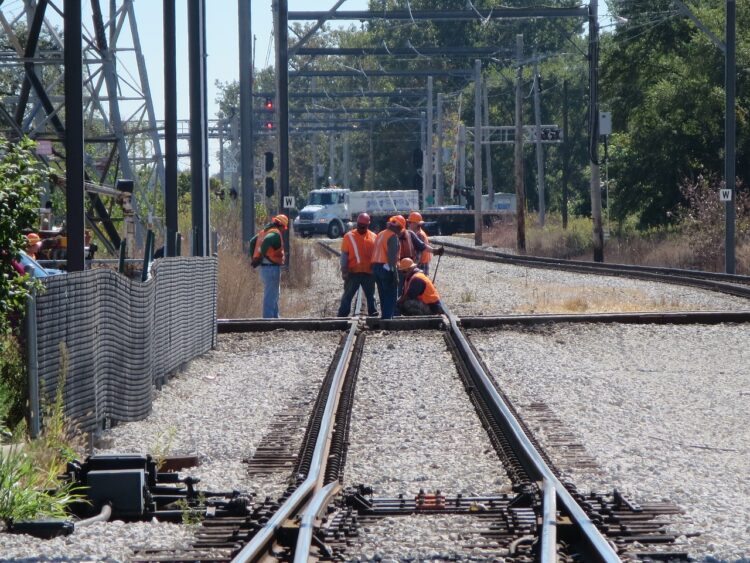Rhine-Alpine News
17.08.2023
Gotthard Basistunnel derailment – tunnel repairs to take several months

Source: Picture by Hpgruesen on Pixabay
In the early afternoon of Thursday 10th of August, a freight train with 30 freight wagons derailed in the Gotthard Basistunnel. After their arrival in Chiasso from different departure points in Italy, they were checked by the SBB.
These checks included both an operational and technical wagon and train check. No irregularities were found. The freight train passed automatic control devices on its way from Bellinzona to the Tunnel without triggering any alarms. The Swiss Safety Investigation Authority (SUST) and the public prosecutor’s office of the Canton of Ticino are investigating the cause of the accident.
Freight traffic can use one lane through the base tunnel as of 23 August. The temporary gate will allow the undamaged east tunnel to be used for freight traffic, probably from 23 August 2023. However, only some goods trains will continue to be diverted via the Gotthard panorama route and via the Lötschberg-Simplon axis, as not all freight trains are suitable for them.
Following further examinations, it became obvious that the magnitude of the damage was far more than initially estimated. Approximately 8 kilometers of track and 20,000 concrete sleepers must be replaced. The track bed near the Faido gauge change is extensively damaged. It will take several months to replace all destroyed elements of the railway facilities. SBB now anticipates that both tunnel tubes will reopen to a limited extent for rail service in early 2024.
Source(in German):
Port of Antwerp-Bruges, Hamburg, and Rotterdam named top three of most automated ports in Europe

Source: Picture by Geralt on Pixabay
In a recent article by Port Technology International, the ports of Antwerp-Bruges, Hamburg, and Rotterdam were named as being in the top three ports to have made the greatest progress in terms of technological innovation.
Port of Antwerp-Bruges
The Port of Antwerp-Bruges, as a core component, has built a Digital Twin that integrates multiple activities inside the port’s digital nervous system. Its major goal is to equip all port staff with situational awareness, providing a comprehensive perspective of operations and supporting informed decision-making. Building on this advancement, the port debuted the ‘D-Hive drone-in-a-box’ network in May 2023, with the primary goal of improving security within the port region. This network will cover an area of more than 120 square kilometres, providing complete surveillance and monitoring capabilities throughout the Antwerp port region. The primary goal is to offer port authorities with a unique aerial perspective, allowing for the effective management, inspection, and monitoring of large land areas. Drones will be used for a variety of duties, including berth management, infrastructure inspections, monitoring operations, identifying oil spills and floating garbage, and assisting security partners during emergencies. Late last year, the Port received approval for the Europa Terminal redevelopment project. This project entails extensive modifications aimed at building an efficient and sustainable terminal. The application of electrification and optimization techniques are predicted to yield a significant annual reduction of 50% in CO2 emissions.
Port of Hamburg
Hamburger Hafen und Logistik AG (HHLA) and ABB Ltd. collaborated in early June to improve efficiency in the long-term operation of large automated stacking crane (ASC) systems. The collaboration will last until the end of 2025, with the goal of unlocking possibilities for further development of systems for automatic stacking cranes, as well as their use, maintenance, and repair. Later that month, the electrification of the storage area at Hamburger HHLA’s Container Terminal Burchardkai (CTB) reached a new milestone with the start-up of four additional contemporary storage blocks. According to reports, the latest advances will accelerate the decarbonization of operations while also lowering emissions at the Port of Hamburg.
The Federal Ministry of Digital and Transport (BMDV) awarded the Hamburg Port Authority (HPA) and DAKOSY Datenkommunikationssystem a grant in early 2022 for the SANTANA project, the goal is to provide infrastructure that allows for greater integration of privately organized logistics, public infrastructure, and traffic control.
Port of Rotterdam
The Port of Rotterdam is regarded as an industry pioneer, having driven the technological transition in the ports business. In the recent year, the port has been extremely busy introducing, testing, and deploying new technology, which included the installation of a sensor network across a 12,500-hectare port area, as well as the ambitious Digital Twin project. The Port of Rotterdam Authority put six “smart bollards” along the quay of the Hutchison Ports ECT Delta terminal on the Maasvlakte in late March 2023, the strength of the mooring lines is measured by these bollards. By obtaining this information, the port hopes to improve its understanding of the ramifications of containership berthing, docking, and idle periods at the quay.
Furthermore, earlier this year, the Port implemented Nextlogic, an integrated planning solution specifically developed to handle the port’s inland container shipping operations. The key goal is to improve the efficiency and promptness of handling inland vessels while optimizing quay utilization by continuously updating the most optimal schedules for barge operators and terminals on a 24-hour basis.
With the introduction of a new secure quantum network by Q*Bird, the Port of Rotterdam made substantial advances in improving communication systems within and around the port by connecting many users via a central hub located near the Port of Rotterdam, providing enhanced security and reliability. This will connect customers to the Port of Rotterdam’s data-sharing platform, Portbase, as well as numerous other logistics enterprises located within the port. Efficient communication networks are critical for the Port of Rotterdam, which handles a significant volume of 15 million TEU each year. As a result, this technological development is said to improve the safety of tens of thousands of marine vessels every year.
Source:
Railway line on the Lower Rhine closed for expansion

Source: Picture by HoBoTrails12AM on Pixabay
Beginning 19th of August, Deutsche Bahn will close the railway line on the Lower Rhine between Emmerich and Oberhausen for six weeks.
The 73-kilometer-long railway is part of a European freight corridor that runs from Rotterdam on the North Sea to Genoa on the Mediterranean. It connects directly to the Dutch Betuwe Line, one of the world’s most modern freight transport routes. However, as freight and passenger traffic have increased in recent years, the line has hit its capacity constraints. As a result, the line is currently being extensively updated.
The three-track expansion of the line serves as the centrepiece, increasing line capacity and optimizing operations. Prior to this, the control and safety technology (LST) at Emmerich was modernized, and the electronic signal box (ESTW) was made operational.
The upgrading of the electrical system at the Dutch border simplifies and saves time for international train travel. The line will also be outfitted with the European Train Control System (ETCS).
Deep foundations and shoring work will be carried out, among other things, to build retaining walls for the building of the third track. Additionally, signalling systems will be modernized, the overhead line will be replaced, and the track will be renewed.
Source(In German):
